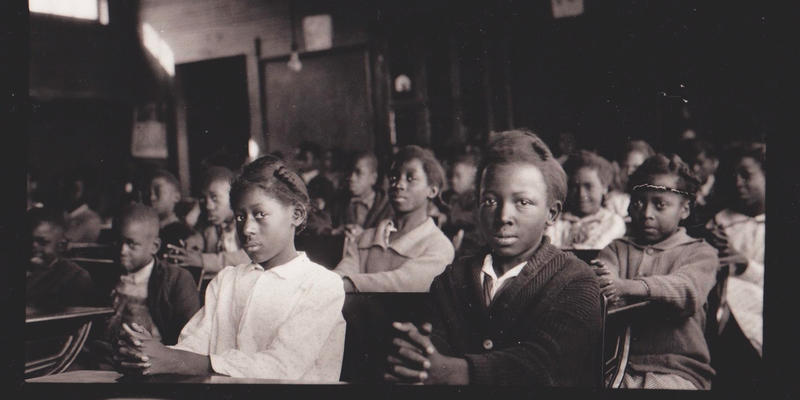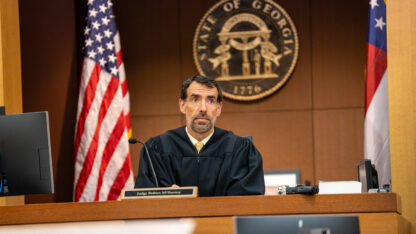Early African-American Schools Refuted White Supremacists’ View

This photo taken around 1930 shows African-American children in a school that wouldn’t have existed just decades earlier.
DR. HORACE MANN BOND © JAMES BOND
At the start of the Great Depression, Horace Mann Bond, father of the late civil rights leader Julian Bond, journeyed into the rural South to document the condition of African-American schools.
The photos he brought back show what some at the time refused to believe — that Southern black children wanted an education.
A new exhibit at Gallery L1 in Atlanta’s Old Fourth Ward is presenting these images to the public for the first time.

1930s Negatives
“You don’t see many photographs from this era, from the rural South,” says Jason Maris, a photographer and curator of the Gallery show.
The exhibit will feature 80 photographs from 1930s negatives that until recently were just sitting in the Bond family’s longtime Southwest Atlanta home. In the frames, one sees wooden one-room schoolhouses, children smiling in dusty clothing and teachers looking respectable.

Among the photographs, Maris points out one of a girl standing at a chalkboard: “She’s wearing tights, she’s got boots. Obviously they’re really dusty. She works. It’s a beautiful photograph.” But beautiful photography wasn’t Horace Bond’s primary goal.
These photos really were evidence, collected by the respected black scholar, for an organization called the Rosenwald Fund.
The Rosenwald Schools
“You have to understand what had happened before 1930,” says Steve Suitts, a senior fellow at the Southern Education Foundation. “In the South, Jim Crow, legal and factual segregation had been put in place and solidified since the turn of the century.”
At that time, segregation didn’t just mean that black children were educated in different schools; it meant in many places they had no schools.
“The white supremacist view was that educating black folks didn’t make any sense because they didn’t need education,” says Suitts. “But there was a corollary of that view. And it was that black folks weren’t interested. You could build the finest school in the world, the white supremacist would say, but black folks wouldn’t go to it. They’re not interested in education, and they’re not capable of it.”

But in the early 1900s, an effort began to combat this view. A powerful Chicago businessman named Julius
Rosenwald, who led the Sears and Roebuck enterprise, teamed up with famous African-American educator Booker T. Washington to build schools in the rural South.
“Now Rosenwald’s money did not support all of the building of the schools,” says Suitts. “What primarily happened is that the black community, with their pennies and sweat equity, put in more money in building their own schools than did Julius Rosenwald.”
By the 1930s, more than 5,000 of these “Rosenwald Schools,” as they were often called, had been built.
Horace Mann Bond’s Evidence
Horace Bond, who was born in Tennessee but earned his doctorate in the North, was sent to report on these schools’ success.
James George Bond, his other son, says his father had a personal interest in documenting achievement among African-Americans.
“Well, I think he was hoping to prove that it’s environment, that if you give people the opportunity, they’ll achieve,” says Bond. “It’s not based on genes, it’s not based on who you are, it’s based on you know what you do.”
Those pictures that Horace Mann Bond took of the schools and the children and adults in those schools show that the white segregated South was not succeeding. – Steve Suitts.
So Horace Bond and his wife Julia traveled to 700 black schools around North Carolina, Alabama and Louisiana, where he stayed for months, even when it was clear that his job could get him killed.
But what he saw and captured with his camera was crucial: Schoolhouses, even ones that were little more than shacks; teachers leading lessons on chalky boards, and, most importantly, children sitting at school desks and learning.
“Those pictures that Horace Mann Bond took of the schools and the children and adults in those schools show that the white segregated South was not succeeding,” says Suitts.
A First Step
Bond was an academic and an activist, but he was not a professional photographer. Some of his photos that will go on display are slightly out of focus or overexposed, but his surviving son, James, says they tell the story of his father’s life’s work. He and his two siblings, including Julian before he passed away, have wanted the photos to be shown publicly for some time.

“I remember the advice my father gave me, was don’t stop and say that’ll do, that’s good enough,” Bond says, “that you have to keep going until you achieve what you want to do.”
His father, Horace Bond, believed education was the best way to defeat segregation. And while it wasn’t until 1954 that the U.S. Supreme Court ruled segregated public schools unconstitutional, the Rosenwald Schools were a first step.
Dr. Horace Mann Bond’s photos will go on display Saturday at Gallery L1 as part of Atlanta Celebrates Photography.








